Abstract
Drones have become popular with the general public for viewing and filming marine life. One amateur enthusiast platform, DroneSharkApp, films marine life in the waters off Sydney, Australia year-round and posts their observations on social media. The drone observations include the behaviours of a variety of coastal marine wildlife species, including sharks, rays, fur seals, dolphins and fish, as well as migratory species such as migrating humpback whales. Given the extensive effort and multiple recordings of the presence, behaviour and interactions of various species with humans provided by DroneSharkApp, we explored its utility for providing biologically meaningful observations of marine wildlife. Using social media posts from the DroneSharkApp Instagram page, a total of 678 wildlife videos were assessed from 432 days of observation collected by a single observer. This included 94 feeding behaviours or events for fur seals (n = 58) and dolphins (n = 33), two feeding events for white sharks and one feeding event for a humpback whale. DroneSharkApp documented 101 interactions with sharks and humans (swimmers and surfers), demonstrating the frequent, mainly innocuous human–shark overlap off some of Australia’s busiest beaches. Finally, DroneSharkApp provided multiple observations of humpback and dwarf minke whales with calves travelling north, indicating calving occurring well south of traditional northern Queensland breeding waters. Collaboration between scientists and citizen scientists such as those involved with DroneSharkApp can greatly and quantitatively increase the biological understanding of marine wildlife data.
Keywords:
drone; drones; marine life; shark; whale; human-wildlife; citizen science; feeding; social media; behaviour 1. Introduction
The use of drones in wildlife research has enabled the collection of new information via readily accessible technologies [1]. For marine research, drones have made it safer and more cost-effective to study a variety of species [2,3]. In some cases, drones have replaced the need for close vessel approaches or vessels completely, e.g., when researching whales [4], and have enabled research to be conducted from the shore, e.g., in white shark research [5]. Drones have also been proven to be versatile tools for collecting animal morphometrics information relating to Australian sea lion size [6], dolphin pregnancy [7], lung microbiota or viruses in humpback whales [4,8], species abundance in sea turtles [2], species distribution [9], density in jelly fish [10], behaviour in leopard seal predation [11] and sting ray behaviour and habitat use [12]. Despite several challenges, such as limitations in terms of flight time, range and weather-dependent flying (e.g., low wind and little rain), drones offer multiple opportunities to collect observations that were not previously possible.
Drone use by the general public has also become a popular method of observing and filming marine life. The advancements in drone technology, reductions in cost and ready availability have resulted in many high-quality observations of marine animals; such observations potentially can contribute to science, even when scientists have not been in the field [13]. In some cases, high observer efforts have enabled the general public to document information (usually via social media) on the presence, habitat use and interactions of various species with humans. Consecutive years of effort have also led to new knowledge of marine life behaviour in lieu of formal scientific observations [14]. As a result, scientists have been investigating potential applications using observations from such platforms to learn more about marine life.
DroneSharkApp is an observation platform that uses drones to document marine life off the coast of Sydney, Australia. Having started in October 2017, DroneSharkApp posts nearly daily captures of habitat use and behaviours of coastal marine species through exhaustively searching a local region and filming sharks, fur seals, dolphins, rays and fish, as well as their interactions with humans. Migratory whale species are also filmed seasonally when present. The DroneSharkApp was originally created to film surfing conditions and promote awareness of sharks; however, it has expanded to make frequent observations of diverse coastal marine life. Sighting information is regularly provided to the public via a dedicated app and through communication with local surf clubs and via social media platforms (e.g., Instagram, Facebook, TikTok). Additional drone observations are occasionally made from other locations in New South Wales (NSW), including Byron Bay (northern NSW) and Jervis Bay (southern NSW).
Given the extensive effort and the records of the presence, behaviour and interactions of various species with humans provided by the DroneSharkApp, we assessed the quality and reliability of the information for scientific investigation. Specifically, we aimed to assess whether DroneSharkApp observations made off the coast of Sydney, Australia could provide information on the presence, behaviour and interactions of various species with humans. Finally, we propose that formal collaboration (the creation of a citizen science program) with observation platforms such as DroneSharkApp can improve our understanding of the local use of habitats by marine wildlife, as well as providing a large increase in observations of species presence and potentially phenology in a changing world.
2. Materials and Methods
Marine wildlife sightings were collected via drone from three main beaches off the coast of Sydney, Australia, namely Bondi, Tamarama and Bronte Beaches (Figure 1).
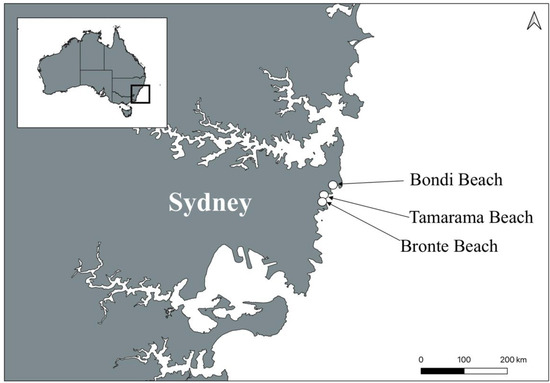
Figure 1.
DroneSharkApp’s land-based drone flying locations off Sydney, Australia. Drone observations of coastal marine life are regularly made from three Sydney beaches, namely Bondi, Tamarama and Bronte Beaches.
All observations were made by a single observer (Jason Iggleden, J.I.). Drone operations occurred from sunrise (0600) to mid-morning (0900-1000) and were limited to conditions of low wind (<45 km/h), no rain and good visibility (>1 km). Observations were made on average for three hours each morning (a flying session) and were stopped if drone operations were unable to continue due to poor weather conditions. Drone flights were not systematic and the intend was to spot wildlife and film any activity in the area through a simple haphazard search or scan of the area. Drone flights were kept within line of sight (within ~1 km) and limited by battery flight time.
All drone operations were performed in accordance with the New South Wales National Parks and Wildlife regulations for flying over marine animals (<100 m) (New South Wales Government, 2021) and conducted by an Australian Civil Aviation Safety Approved (CASA) Pilot (No.1031900). No animal ethics or scientific licences were obtained as this observation platform was not intended for scientific purposes.
Drone videos from each day were compiled during or after each flying session. Videos were made available via the DroneSharkApp application (paid service). A smaller portion of the content was also freely accessible to the public via the DroneSharkApp Instagram page (used for this study) and additional social media platforms (e.g., Facebook, TikTok). For bad weather days or when flying was not conducted, additional content was posted or previously shared content was reshared.
Video Assessment
Videos posted on DroneSharkApp’s Instagram page (@dronesharkapp, Meta Platforms) were observed for the following information: location, species present, behaviour (e.g., feeding, swimming), interspecies association and specifically for sharks swimming with humans (swimmers and surfers). If sharks were present with humans, additional information on the general proximity between human and shark interactions were documented, e.g., observed within the frame (if both shark/s and human present in the same frame) or shark/s observed within the vicinity of humans in the same video.
The number of video posts used in this study and the actual number of days spent in the field were determined by identifying the date when videos were posted to Instagram and the description provided for each post. This ensured resharing of the same footage and that additional footage posted from the same day was not duplicated in the counting process. On one occasion, a post consisted of a mixture of new and previously shared footage. All uncertainties were clarified by JI.
3. Results
Drone Footage
Drone footage of marine life was collected between June 2018 and September 2021 (three years and three months) from Sydney, Australia (Figure 1). Drone observations continue to be made beyond this timeframe and from additional locations along the Australian East Coast (excluded from this study). A total of 678 wildlife videos posted to social media were assessed from 432 days of observations collected by a single observer. The higher number of videos compared with days in the field was a result of several factors, including multiple posts for some days, resharing of content from previous days and additional footage being provided during no-fly days, e.g., poor weather (rain, high winds, poor visibility) or when not in the field.
A variety of marine wildlife species were observed during drone flights off Sydney, Australia, including shark species such as the critically endangered grey nurse shark (Carcharias taurus), which was most the commonly seen shark (Table 1). White sharks, hammerhead sharks and most likely whaler species (unconfirmed Carcharhinus spp., e.g., bull and bronze whalers) were also seen. Other sightings included dolphins (mainly inshore bottlenose dolphins, Tursiops aduncus), fur seals (New Zealand fur seal, Arctocephalus forsteri), rays, various fish species (e.g., bump-head sunfish, Mola alexandrini) and migratory whales (Table 1). Humpback whales (Megaptera novaeangliae) were most commonly observed, along with dwarf minke (Balaenoptera acutorostrata) and southern right whales (Eubalaena australis).

Table 1.
Marine life documented from drone observations off Sydney, Australia between October 2017 and September 2021. A variety of marine species were observed, including shark species, dolphins, fur seals, migratory whales, rays and various fish species (e.g., sunfish, Mola alexandrini).
Across the study period, shark sightings were higher compared to other wildlife, especially for the months of June (Austral winter) and December (summer) (Figure 2). Fur seals were most commonly sighted in winter, as were rays. Dolphin sightings were lower in the summer months. As expected, whale observations commenced from May (Autumn) and were reduced in November and December. This was consistent with the northward and southward migration commonly observed along the east coast of Australia (Pirotta et al., 2017).
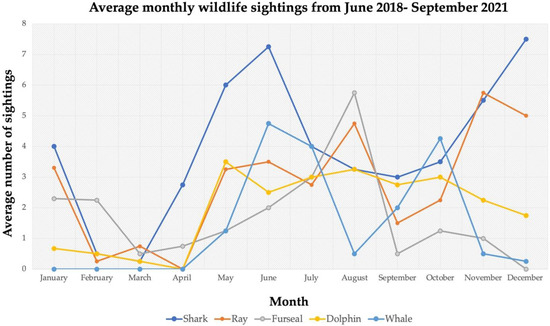
Figure 2.
Average monthly wildlife sightings from June 2018 to September 2021 across the study period reported by DroneSharkApp off Sydney, Australia. Sightings were limited by observer effort, which was not recorded across the study.
The inspection of sightings by season provided an overview of the types of wildlife documented across the study period (Figure 3). Shark sightings were generally higher across all seasons compared with other marine life.
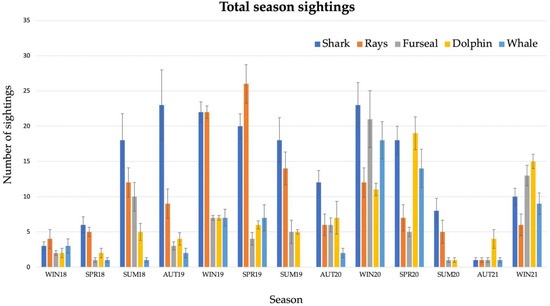
Figure 3.
Seasonal sightings of marine wildlife observed via drone by the DroneSharkApp off Sydney, Australia.
Feeding Events
A total of 94 feeding events were observed (Figure 4) (Supplementary Materials). Fur seal predation (n = 58) was mainly on fish; however, two individuals were also observed consuming octopus post-capture. In total, 33 dolphin feeding events were recorded, consisting of group feeding behaviours (n = 26) and individual feeding (n = 7). Both fur seals and dolphins (bottlenose and common species) were observed targeting bait balls (large congregations of fish schools) and smaller groups of fish (fur seal and bottlenose dolphin only). A humpback whale was also observed lunge feeding, most likely on krill (n = 1), and there were two feeding events by a white shark.
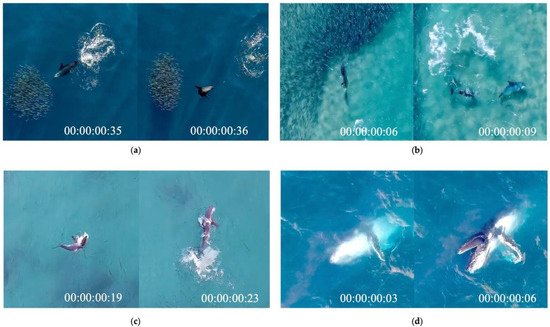
Figure 4.
Evidence of multispecies feeding behaviour captured by drone via the DroneSharkApp off Sydney, Australia: (a) New Zealand fur seal (Arctocephalus forsteri) predates on a small school of fish, successfully separating a single individual; (b) bottlenose dolphins (Tursiops aduncus) swim into a school of fish in shallow waters, capturing a fish; (c) a white shark (Carcharodon carcharias) targets a single fish, biting onto the individual before circling around to grab the fish once again and thrash its body; (d) a humpback whale (Megaptera novaeangliae) observed surface lunge feeding, turning onto its side and exposing its baleen plates.
A total of 101 cases of co-occurrence between humans (swimmers and surfers) and sharks sharing the water was observed (Figure 5).
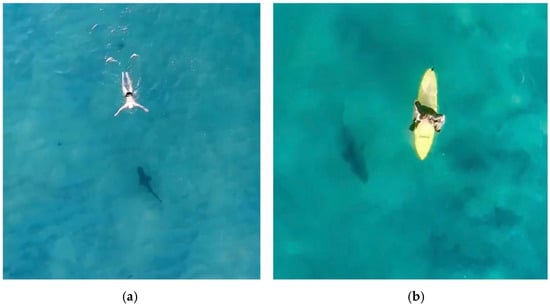
Figure 5.
Drone observations of shark interactions with humans observed by the DroneSharkApp off Sydney, Australia: (a) a swimmer off Bondi with an unidentified shark passing beneath; (b) a surfer sits on his surfboard while a grey nurse shark (Carcharias taurus) swims below.
Several interspecies interactions of marine life were documented exploiting shared food resources (e.g., dolphins and fur seals predating on the same bait ball) and swimming in the same areas (e.g., sharks and rays). Social and playful interactions were commonly observed between dolphins and fur seals and less frequently with whales, dolphins and fur seals. Observations of northward-migrating humpback whales with neonates (less than two weeks old) and a dwarf minke whale mother with a calf provided evidence of calving occurring south of Sydney and south of known birthing or breeding grounds in Queensland (Figure 6).
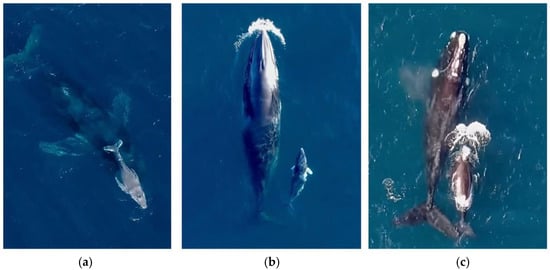
Figure 6.
Migratory whale species observed by drone via DroneSharkApp off Sydney, Australia: (a) northward-migrating humpback whale mother (Megaptera novaeangliae) with small calf, which provides evidence of birth prior to Sydney and northern Queensland breeding grounds; (b) a dwarf minke whale mother and calf headed north past Sydney, also evidence of birth prior to Queensland waters; (c) a southern right whale (Eubalaena australis) mother and calf travel southward past Sydney.
4. Discussion
Advancements in drone technology and accessibility have made drones a popular method of observing marine life. The recreational use of drones by the general public to capture wildlife observations has provided new opportunities for scientists to collect information on marine species. At the same time, information collected in this way can promote awareness of marine wildlife and the marine environment through social media. In this study, field observations collected by DroneSharkApp demonstrate how this observation platform can help document a variety of coastal and migratory marine species off Sydney, Australia. This platform was also able to observe feeding behaviours, social interactions between species and the overlap of habitat use by a variety of species and humans.
Of particular interest was the number of feeding events documented for both fur seals and dolphins, as traditionally these behaviours are very difficult to reliably observe in the wild. The elevated observations were made feasible by use of a drone and the immense effort expended by J.I. in filming for several hours daily, year-round. Exploitation of the same prey sources was most likely the reason for the overlap in habitat and the cause of some social interactions. Observations were made of specific fur seal behaviour used by individuals to forage. This included foraging and searching behaviours (following fish) and prey capture attempts. The direct capture of fish was not observed for fur seals. This may have occurred or was not able to be detected via the drone. Dolphins were observed predating on fish individually and co-operatively. Only two clear examples of fish predation by a shark (white shark) were obtained. Grey nurse sharks were frequently seen in fish schools but not seen predating, most likely due to their nocturnal foraging habits [15].
This study provides direct evidence of the co-occurrence of sharks with humans off three of Australia’s busiest beaches. Grey nurse sharks were most commonly observed in close proximity to humans; however, this species is not generally regarded as a threat to humans and is thought to be placid in nature [16]. Dangerous species such as the white shark were only observed three times over the three-year period, with only one of those observations with humans in close proximity (both humans and shark seen in the same frame). This confirms that the likelihood of encountering larger, typically offshore species e.g., white sharks in this region is relatively low and is consistent with the locally low number of shark bites and few animals caught in the shark meshing program which fishes in this area [17]. Additionally, the presence of a variety of offshore species, e.g., hammerheads, may be as a result of variations in currents and ocean temperatures and following prey distributions [18]. Ongoing information on shark movements from scientific research and the DroneSharkApp may provide information on unusual occurrences of shark species off Sydney and the potential for interactions with humans for bather safety. Shark–human interactions are likely to change as shark distributions are strongly influenced by changes in the marine environment, and these observations may detect these changes in real time [19,20].
In addition to shark observations, migratory species such as humpback, dwarf minke and southern right whales were observed during the winter (northward–southward migration) and spring (southward migration) months. This paper supports the work of Pirotta et al. (2020), which previously documented whale calving occurring further south of Sydney’s waters. Direct observations of dwarf minke whales with calves and mother humpback whales with neonate calves (Figure 4) travelling north suggest that calving occurred south of Sydney’s waters for both species. The platform’s observations of humpback whales feeding off the coast of Sydney expand the distribution of feeding behaviours in NSW waters during the humpback whale’s southern migration [13]. Humpback whales may be using NSW’s waters to supplement feeding energy intakes in addition to Antarctic feeding grounds, taking advantage of possible prey distribution changes occurring in these southeastern Australian waters [13]. Additional observations of humpback whales feeding off Sydney were also made by other recreational drone users who shared their images via social media.
Observations made through the DroneSharkApp observation platform were never intended to be used for science. Without the formal guidance from scientists, this work faces several limitations. For example, the DroneSharkApp is effectively a ‘presence only’ survey of marine life and the amount of effort was recorded; therefore, it did not account for days where no animals were observed or when there was poor weather. There are some social media posts that document days when no animals are sighted and with poor weather; however, reposted footage from previous days was largely used to fill these gaps, as well as on days where poor weather did not allow for flying.
Additionally, information on temporal sightings (Figure 2 and Figure 3) was limited and only provides an indication of wildlife presence at certain times of the year. DroneSharkApp was not based in Sydney for the entire study period and flights from other locations along the Australian East Coast were excluded. Absence (non-flying periods) during certain times of the year off Sydney would have also led to a lower number of observations across seasons and lower sighting information for all species. Sharks were also the main focus of this observation platform, which might explain the higher numbers observed compared with other marine species across the study period. The seasonal component of this data can be used as a guide only. We suggest that a more formal and systematic study is needed to provide an assessment of the presence of species across all seasons off the coast of Sydney.
In addition, our understanding the time of day at which species were present off Sydney was limited by the observation window set for each day (06:00 to 10:00), which was not provided through Instagram. Geographical locations of animals and their distances to the coast were also not recorded. The drone was capable of recording raw data, such as the time and the drone’s position; however, these additional data were not presented to the general public, as they had been discarded. For future data recording, the DroneSharkApp should be equipped with scientific tools such as LIDAR to collect accurate geographical information on animal locations and possible distances from the coast. Scientific guidance with regards to systematic surveys, including the use of set fight routes, sampling across all months, recording times when animals are sighted and recording observer efforts for all future observations, is to be established. Finally, an appropriate online platform for raw flight information should also be considered, enabling further use of the data.
While the above are the limitations of this study, the quality of the images and internal consistency are strengths of this dataset. Observations were always made by the same observer, providing internal reliability. This also ensured that flying was kept to a minimum of 100 m above sea life, as per state flying rule requirements to ensure minimal to zero disturbance of animals. The drone images were able to be magnified or cropped to appear closer than was actually flown in the field. Despite the above constraints, this study provides a new perspective on wildlife activity off the coast of Sydney, Australia.
5. Conclusions
The DroneSharkApp observation platform is an example of the potential for scientists to work collaboratively with the general public to guide meaningful data collection. In this paper, we have provided examples of the types of observations scientists can gather from marine life when scientists are not in the field. Future collaboration between the DroneSharkApp and scientists could transition this observation platform into a formal citizen-science-based study tool. Additional requirements such as animal ethics approval and scientific licences would be needed, as well as training and continued inclusion of citizen scientists within the scientific publication processes (as with this paper) [14]. This will help guide how data are collected going forward. Future research could focus on animal behaviour (e.g., feeding) and potential habituation to humans through the use of ethograms. Furthermore, the exploration of social attitudes towards marine life through social media platforms, such as Instagram, may improve our understanding of follower interactions with different species and contribute to the growing area of ‘marine citizen science’ [21]. This may further aid awareness towards beach safety and our understanding of marine life off the coast of Sydney.
Supplementary Materials
The following supporting information can be downloaded at: https://www.mdpi.com/article/10.3390/drones6030075/s1: Video S1: Fur seal feeding video. Video S2: Dolphin feeding video. Video S3: White shark feeding video. Video S4: Humpback whale feeding video.
Author Contributions
Conceptualization, V.P. and R.H.; methodology, J.I.; data curation, V.P. and J.I.; writing—original draft preparation, V.P., D.P.H. and R.H.; writing—review and editing, V.P., D.P.H. and R.H. All authors have read and agreed to the published version of the manuscript.
Funding
This research received no external funding.
Institutional Review Board Statement
Not applicable.
Informed Consent Statement
Not applicable.
Data Availability Statement
Data on feeding events and human-shark interactions are provided in an Excel workbook.
Acknowledgments
We would like to thank Joni Pini-Fitzsimmons for her stingray expertise and Kerryn Parkinson for her assistance with sunfish species identification.
Conflicts of Interest
The authors declare no conflict of interest.
References
- Christie, K.S.; Gilbert, S.L.; Brown, C.L.; Hatfield, M.; Hanson, L. Unmanned aircraft systems in wildlife research: Current and future applications of a transformative technology. Front. Ecol. Environ. 2016, 14, 241–251. [Google Scholar] [CrossRef]
- Schofield, G.; Esteban, N.; Katselidis, K.A.; Hays, G.C. Drones for research on sea turtles and other marine vertebrates—A review. Biol. Conserv. 2019, 238, 108214. [Google Scholar] [CrossRef]
- Raoult, V.; Colefax, A.P.; Allan, B.M.; Cagnazzi, D.; Castelblanco-Martínez, N.; Ierodiaconou, D.; Johnston, D.W.; Landeo-Yauri, S.; Lyons, M.B.; Pirotta, V.; et al. Operational Protocols for the Use of Drones in Marine Animal Research. Drones 2020, 4, 64. [Google Scholar] [CrossRef]
- Pirotta, V.; Smith, A.; Ostrowski, M.; Russell, D.; Jonsen, I.; Grech, A.; Harcourt, R. An Economical Custom-Built Drone for Assessing Whale Health. Front. Mar. Sci. 2017, 4, 425. [Google Scholar] [CrossRef]
- Tucker, J.P.; Colefax, A.P.; Santos, I.R.; Kelaher, B.P.; Pagendam, D.E.; Butcher, P.A. White shark behaviour altered by stranded whale carcasses: Insights from drones and implications for beach management. Ocean Coast. Manag. 2020, 200, 105477. [Google Scholar] [CrossRef]
- Hodgson, J.C.; Holman, D.; Terauds, A.; Koh, L.P.; Goldsworthy, S.D. Rapid condition monitoring of an endangered marine vertebrate using precise, non-invasive morphometrics. Biol. Conserv. 2020, 242, 108402. [Google Scholar] [CrossRef]
- Cheney, B.J.; Dale, J.; Thompson, P.M.; Quick, N.J. Spy in the sky: A method to identify pregnant small cetaceans. Remote Sens. Ecol. Conserv. 2022. [Google Scholar] [CrossRef]
- Geoghegan, J.L.; Pirotta, V.; Harvey, E.; Smith, A.; Buchmann, J.P.; Ostrowski, M.; Eden, J.-S.; Harcourt, R.; Holmes, E.C. Virological Sampling of Inaccessible Wildlife with Drones. Viruses 2018, 10, 300. [Google Scholar] [CrossRef] [PubMed] [Green Version]
- Kelaher, B.P.; Colefax, A.P.; Tagliafico, A.; Bishop, M.J.; Giles, A.; Butcher, P.A. Assessing variation in assemblages of large marine fauna off ocean beaches using drones. Mar. Freshw. Res. 2019, 71, 68–77. [Google Scholar] [CrossRef] [Green Version]
- Hamel, H.; Lhoumeau, S.; Wahlberg, M.; Javidpour, J. Using Drones to Measure Jellyfish Density in Shallow Estuaries. J. Mar. Sci. Eng. 2021, 9, 659. [Google Scholar] [CrossRef]
- Robbins, J.R.; Poncet, D.; Evans, A.R.; Hocking, D.P. A rare observation of group prey processing in wild leopard seals (Hydrurga leptonyx). Pol. Biol. 2019, 42, 1625–1630. [Google Scholar] [CrossRef]
- Oleksyn, S.; Tosetto, L.; Raoult, V.; Joyce, K.E.; Williamson, J.E. Going Batty: The Challenges and Opportunities of Using Drones to Monitor the Behaviour and Habitat Use of Rays. Drones 2021, 5, 12. [Google Scholar] [CrossRef]
- Pirotta, V.; Owen, K.; Donnelly, D.; Brasier, M.J.; Harcourt, R. First evidence of bubble-net feeding and the formation of ‘super-groups’ by the east Australian population of humpback whales during their southward migration. Aquat. Conserv. Mar. Freshw. Ecosyst. 2021, 31, 2412–2419. [Google Scholar] [CrossRef]
- Pirotta, V.; Reynolds, W.; Ross, G.; Jonsen, I.; Grech, A.; Slip, D.; Harcourt, R. A citizen science approach to long-term monitoring of humpback whales (Megaptera novaeangliae) off Sydney, Australia. Mar. Mammal Sci. 2019, 36, 472–485. [Google Scholar] [CrossRef]
- Barker, S.M.; Peddemors, V.; Williamson, J.E. Recreational SCUBA diver interactions with the critically endangered Grey Nurse Shark Carcharias taurus. Pac. Conserv. Biol. 2010, 16, 261–269. [Google Scholar] [CrossRef]
- Otway, N.M.; Burke, A.L.; Morrison, N.S.; Parker, P.C. Monitoring and Identification of NSW Critical Habitat Sites for Con-Servation of Grey Nurse Sharks; Final Report to Environment Australia; Project No. 22499; NSW Fisheries Final Report Series No. 47; NSW Fisheries Office of Conservation: Nelson Bay, Australia, 2003; 62p, ISSN 1440-3544. [Google Scholar]
- Niella, Y.; Peddemors, V.M.; Green, M.; Smoothey, A.F.; Harcourt, R. A “Wicked Problem” Reconciling Human-Shark Conflict, Shark Bite Mitigation, and Threatened Species. Front. Conserv. Sci. 2021, 2, 78. [Google Scholar] [CrossRef]
- Lee, K.; Butcher, P.; Harcourt, R.; Patterson, T.; Peddemors, V.; Roughan, M.; Harasti, D.; Smoothey, A.; Bradford, R. Oceanographic conditions associated with white shark (Carcharodon carcharias) habitat use along eastern Australia. Mar. Ecol. Prog. Ser. 2021, 659, 143–159. [Google Scholar] [CrossRef]
- Niella, Y.; Smoothey, A.; Peddemors, V.; Harcourt, R. Predicting changes in distribution of a large coastal shark in the face of the strengthening East Australian Current. Mar. Ecol. Prog. Ser. 2020, 642, 163–177. [Google Scholar] [CrossRef]
- Niella, Y.; Butcher, P.; Holmes, B.; Barnett, A.; Harcourt, R. Forecasting intraspecific changes in distribution of a wide-ranging marine predator under climate change. Oecologia 2021, 198, 111–124. [Google Scholar] [CrossRef] [PubMed]
- Garcia-Soto, C.; Seys, J.J.C.; Zielinski, O.; Busch, J.A.; Luna, S.I.; Baez, J.C.; Domegan, C.; Dubsky, K.; Kotynska-Zielinska, I.; Loubat, P.; et al. Marine Citizen Science: Current State in Europe and New Technological Developments. Front. Mar. Sci. 2021, 8, 241. [Google Scholar] [CrossRef]
Publisher’s Note: MDPI stays neutral with regard to jurisdictional claims in published maps and institutional affiliations. |
© 2022 by the authors. Licensee MDPI, Basel, Switzerland. This article is an open access article distributed under the terms and conditions of the Creative Commons Attribution (CC BY) license (https://creativecommons.org/licenses/by/4.0/).